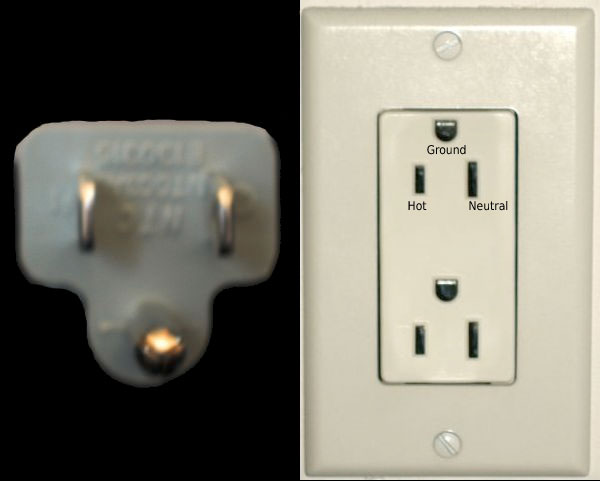I could use some advice from anyone with electrical, appliance, and/or construction experience.
I’ve got an old air conditioner in my apartment. It’s the same one I had when I moved in, so it’s at least 30 years old. I’ve also got Apple Homekit set up for other devices in my apartment (light bults and fans).
The goal: control my air conditioner through Homekit. The dream: Before I go home, I turn on the A/C remotely so the apartment will be cool when I get there. Double dream: use Homekit to connect my thermostat to the A/C so that it would turn on if the apartment temperature got over 85 degrees, to keep my pets comfortable.
There are plenty of Homekit devices that plug into conventional wall outlets. Here’s one that I already use.
For those of you keeping score at home, most home plugs and outlets are NEMA 5-15:

This old A/C uses a NEMA 6-15 plug, I think; it’s pretty grungy after 30 years. It looks like this:

A new plug of this type looks like this:

The outlet looks like this (it was the best I could do sticking my iPhone behind a bookcase):

This looks like a NEMA 6-20 outlet, but it doesn’t match what’s in use today. A current NEMA 6-20 outlet looks like this:
Again, for those like me who are keeping score at home, this means that my A/C can draw up to 15 amps of current at 240 volts.
The studliest Homekit switch I know of is the Eve Energy Smartplug. It can handle up to 250V, it’s rated for 11A at the most. With my current A/C, even if I could solve the outlet compatibility issues, either a circuit breaker would trip or a fuse would blow if I used it for my air conditioner.
So now we get to the advice I need from people who know what they’re doing:
- Is it possible to set up some kind of relay so a 15A/120V device can control a 20A/240V device? My web searches suggest that it’s possible, but you need to have electrical experience to construct one and no one has put up any “how to” plans yet. Can you think of something?
- As I said, my current A/C is over 30 years old. It is certainly not energy efficient. It’s not remote controlled (so devices like Tado won’t work). The latch that lets in air from the outside froze shut 20 years ago, so I can’t use just the fan to vent in cool air when it’s hotter inside than outside. And you can see the picture of the plug above; I’m not sure it’s safe anymore.
So I’m willing to consider buying a new one. There are Homekit-compatible air conditioners coming onto the market. That leads to contractor-style questions:
- They make plenty of wall-mounted air conditioners with NEMA 6-15P plugs. I can’t seem to find one that’s Homekit compatible. Do you know of any? (Translation: Is your web-fu better than mine?) Or will I have to accept a Tado-like solution?
- Alternatively, modern air conditioners draw less current than my old A/C. My living room is about 400 square feet. A decent wall-mounted air conditioner like this one draws less than 5 amps. So it’s theoretically possible to use the Eve Smartplug, if I can solve the outlet compatibility issue.
- Is it worth solving this problem a different way, by replacing that old NEMA 6-20 outlet with a NEMA 5-15, with a suitable downgrade in voltage? Then an unmodified Eve Smartplug would work. I’m certain that a modern A/C with a NEMA 5-15 plug could handle 400 square feet.
- How difficult is it to replace a wall-mounted air conditioner? My preliminary web search says that it’s not that difficult, but I’m clumsy when it comes to this sort of work. Is this the sort of thing that I’d have to hire a contractor to do?
Before you ask: I’ve got a good relationship with my superintendent. He doesn’t mind me doing this sort of work in my apartment, as long as I don’t get him and the landlord involved.
I’ll gratefully listen to any advice, even if that advice must be “Suck it up, Homekit-boy, and live with what you’ve got.”